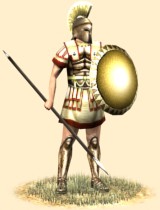Difference between revisions of "Hoplite (RTW Unit)"
m (→Pontus) |
m (→Historical Overview) |
||
| Line 7: | Line 7: | ||
==Historical Overview== | ==Historical Overview== | ||
| − | Hoplites were | + | Hoplites were citizen-militia, probably first appearing in the late 600s BCE. Hoplites generally consisted of middle-class greeks, as they could afford their own equipment. As Ancient Greece was an agriculture-based society, most states could not afford a standing professional army (with the exception of Sparta), so as a result warfare in Greece was intended to be decisive. Most wars were concluded with surprisingly few deaths, sometimes in even one pitched battle. However Hoplites began to decline over the centuries, with the Peloponnesian war more focus went on to peltasts (light skirmishers), navies, mercenaries, and siege-engines. This also had the effect of greatly increasing the death toll, with this war and those following it greatly tiring Greece out, enough to facilitate a relatively easy conquest by Macedonia 66 years later. After this, Hoplite warfare began to die out and be replaced with the more flexible Macedonian variety. |
==Gameplay== | ==Gameplay== | ||
Revision as of 01:09, 7 November 2024
The Hoplite was the backbone of Hellenic warfare, just as the Legionaries would become that of the Romans.
As such, they play an important role in Rome: Total War.
Contents
Historical Overview
Hoplites were citizen-militia, probably first appearing in the late 600s BCE. Hoplites generally consisted of middle-class greeks, as they could afford their own equipment. As Ancient Greece was an agriculture-based society, most states could not afford a standing professional army (with the exception of Sparta), so as a result warfare in Greece was intended to be decisive. Most wars were concluded with surprisingly few deaths, sometimes in even one pitched battle. However Hoplites began to decline over the centuries, with the Peloponnesian war more focus went on to peltasts (light skirmishers), navies, mercenaries, and siege-engines. This also had the effect of greatly increasing the death toll, with this war and those following it greatly tiring Greece out, enough to facilitate a relatively easy conquest by Macedonia 66 years later. After this, Hoplite warfare began to die out and be replaced with the more flexible Macedonian variety.
Gameplay
All Hoplites have the ability to form the deadly phalanx formation. They are nearly impervious to frontal assaults, however they are generally slow and cumbersome, their rigid formation can easily be exploited with attacks to the side or rear. Generally Hoplites should be used in the Hammer and Anvil tactic Alexander The Great employed. The Hoplites hold the enemy, while another force (Be it cavalry or more manoeuvrable infantry) destroys the enemy by the rear. It is wise to always support a Hoplite line with lighter infantry in case of flanking manoeuvres.
